Reclaiming public space: An exclusive long-read design profile of Keigo Kobayashi and Haruka Uemura

The cavernous atrium becomes a study in figural representation. Bodies contort in space, availing themselves of the gentle sloping bench to sit gingerly, lay down their bags, and lean in repose for a moment’s rest before leaping up and continuing on their way. Large swathes of thin sky blue cloth sway overhead, as if buoyed by the distant breeze of some languorous tropical afternoon. All along, indigenous horses and the unblinking face of a young girl stare out on the proceedings, projections from where Japan ends and the sea begins.
Onlookers peer back at the screen in rapt attention. But others appear to be mere interlopers, content to simply bask in the afterglow as light filters through the building’s glass block walls, quietly lapping at the curved wooden partitions that carve concentric paths through the space to curiously intimate effect.
The scene inspires a certain kinship between fellow strangers sharing their Sunday in this space.
The date: August 2020.
The place: Ginza Hermes, site of Charlotte Dumas’ BEZOAR (Calculus).
Not far across town just two years prior, a clock tower, treehouse, and architectural ruins dissected like a chiffon cake were strewn about the premises of the National Museum of Modern Art, Tokyo. Museum-goers could be forgiven for forgetting they were in a gallery. Or rather, this sensory ambiguity was the point; the outsized wooden staircase, jungle gym, and a fence enclosing detritus plucked from Tokyo’s streets imparted the illusion of spending an afternoon in a park, or rather, immersed in a fever dream of Gordon Matta-Clark.
These exhibitions were linked by the thread of gestalt assemblages, or urban fragments sprung from the imagination of a cast of creatives spanning decades and metropolises around the globe.

Behind the curtain we find Keigo Kobayashi, co-founder of architecture design office NoRA, and Haruka Uemura, who practice architectural design as well as running her own textile design firm Studio Onder De Linde. Currently based in Tokyo, both started their careers in Rotterdam — in Kobayashi’s case, at the OMA office of Rem Koolhaas.
“I firmly believe that clever design has the power to draw out mankind’s latent instinct for space, an instinct that now largely lays dormant in our subconscious. I’m interested in design that permits uncertainty, allowing spontaneous mutation.
”By confronting spaces and situational contexts, museum-goers elicit new consciousnesses and sense the thrill of discovery. These sensations imprint in memory, passing the mucus membrane to percolate through society, where they are spit out to live in cities and public spaces. This potential for positive output, the sort that enriches the quotidian routine, is always in the back of my mind when designing.”
Spaces designed by Kobayashi and Uemura echo the Jungian arc, a mirror into the subconscious, viewed through the vector of psychosomatic experience, teasing out and reconstructing identities in a process akin to confession, catharsis, elucidation, education, and transformation.
These processes speak to a brand of introspection severely lacking in recent years, as the ever-accelerating wheels of technology and material production barreled down on a collision course with catastrophe.
Especially now that space has taken on new meaning amid the COVID pandemic, we spoke with Kobayashi regarding the social and physical ramifications of spaces he creates with Uemura, as well as the potential of design.
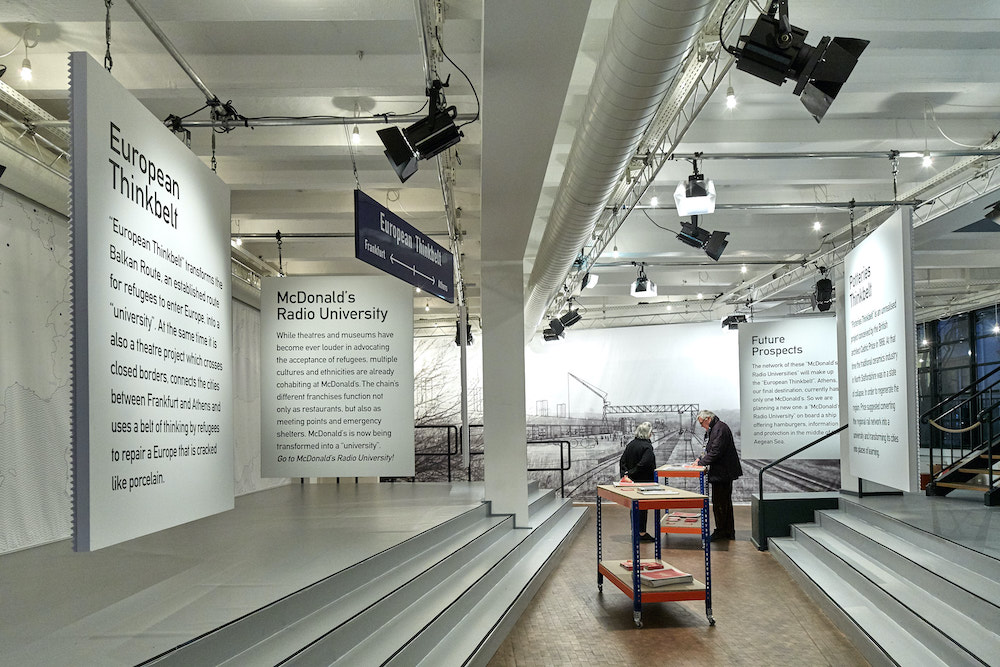
McDonald’s Radio University / European Thinkbelt (2016)
Around 2015, a long procession of refugees fleeing war-torn Syria and elsewhere in the Middle East wound their way north along the so-called “Balkan route” stretching from Athens to Frankfurt. As these displaced peoples embarked on new lives, they now contended with a reckoning in their adopted homes, catalysing convoluted conversations over the humanitarian cause that had arrived in the locals’ own backyards. Overnight, professionals who had excelled in highly-specialized fields in their home countries, found themselves lumped under the anonymising appellation, “refugee.”
In response, theatre director Akira Takayama launched “McDonald’s Radio University” (MRU), as a platform for refugees to share their expertise and foster community ties. For the spatial design, he tapped Kobayashi and Uemura.
More than just greasy comfort food, the McDonald’s franchise had come to represent a reliable base for the immigrant community as a comforting meeting ground and a bastion of 24/7 Wi-Fi.
Kobayashi transformed the Künstlerhaus Mousonturm theatre into a model McDonald’s in Frankfurt. Upon sidling up the counter, patrons could order headphones and satiate their intellectual appetites from a menu of lectures ranging from literature to journalism and architecture — with a side of hamburgers and a Coca-Cola, too.
After savouring dinner and a lecture, visitors could exit into the lobby to ruminate over European Thinkbelt, a coterminous exhibition by Kobayashi introducing the MRU project. Probing a new paradigm reframing the relationship between refugees and locals, the installation posited the MRU as a decentralised university network, fanning out across the Balkan route, in homage to Cedric Price’s Potteries Thinkbelt.
Conceived by Price in the 1960s, Potteries Thinkbelt envisaged a mobile “university” campus circulating between three dilapidated train stations around the abandoned coal mines of Staffordshire.
Kobayashi says the installation provided unanticipated gleanings into behavioural dynamics and the transformative power of architecture.
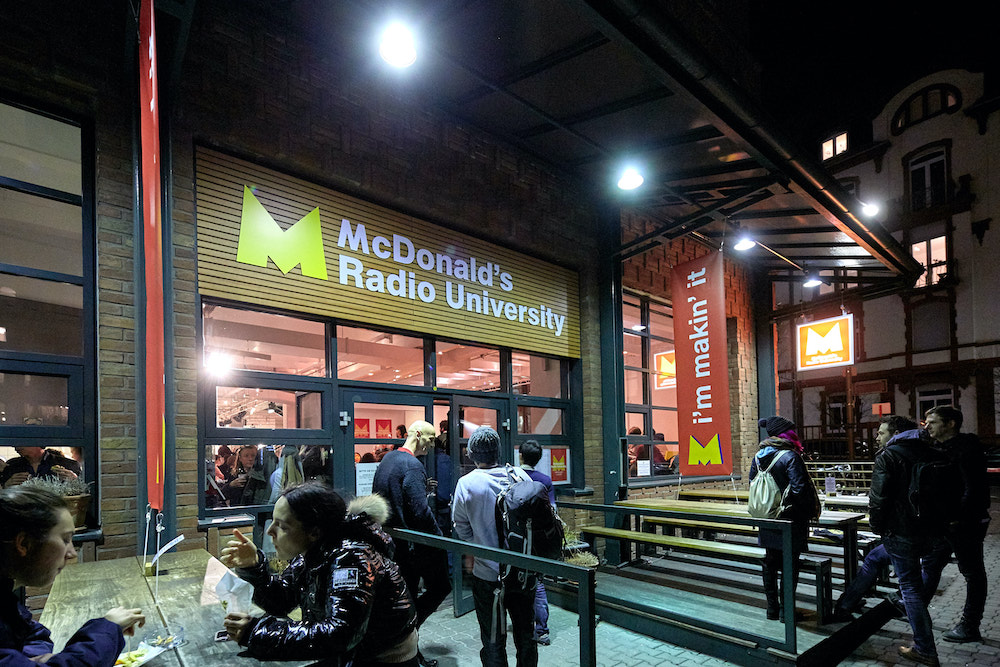
“The Künstlerhaus Mousonturm’s foyer has a concrete staircase stepping down from the entry. We erected steps on the opposite side of these elevations, creating a symmetrical stair platform that echoed the platforms of the train stations in Potteries Thinkbelt.
“On opening day, visitors ended up congregating on the stairs, using them as seats while engrossed in conversation. To our surprise, people began taking turns demonstrating traditional dance from their homelands, in the floor space between the stairs representing the train tracks, in a spontaneous performance.
“I was reminded of another Price project, the Fun Palace, conceived with theatre director Joan Littlewood. Although never realised, they proposed spaces that encourage interaction, bringing together communities to autonomously create a new shared culture of their own.
“Price said it was time to furnish a ‘short-term plaything in which all of us can realise the possibilities and delights,’ with adaptable stages, lighting, and sound equipment. Breaking free from scripted theatrical productions, he envisaged a flexible framework where the common man could be the centre of the action, free to ‘choose what you want to do — or watch someone else doing it.’
“Ultimately, we hope that our spaces function as a platform and catalyst for these situational happenings. We think this social enterprise speaks to one of the fundamental higher aims of design.”
After copious negotiation on the part of Mousonturm, McDonald’s agreed to offer actual restaurants as MRU campuses.
“Such corporate collaborations do run the risk of allowing art to be cannibalized by the very symbol of consumerism. But Takayama has a more inclusive stance toward art, and welcomed the proposal for its experimental potential.
“The metamorphosis from conceptual art to practicable infrastructure is desirable in its own way. I’ve been deeply impressed by Takayama’s unwavering commitment to creating projects that beget social transformation.”
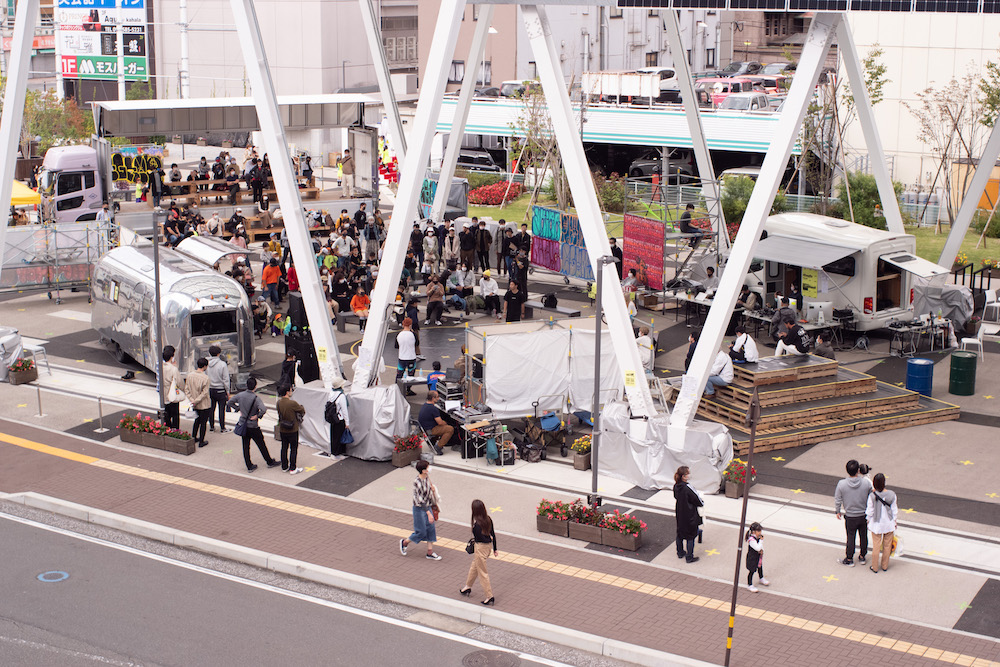
Wagner Project (2017)
Takayama followed MRU with the Wagner Project, which brought Richard Wagner’s Die Meistersinger von Nürnberg to the streets, transposing the opera into the 21st century context of hip-hop and rap, in a series of events conducted in Kanazawa, Frankfurt, and Oita.
The playbill was filled through open auditions to recruit amateur rappers and performers from the community, who demonstrated their mettle accompanied by lectures from professional wordsmiths, ranging from poets to academics and veteran rappers. Participants fleshed out the program together in a weeklong bootcamp, culminating in a series of live performances. Both the incubatory workshops and live acts were conducted in front of an audience of ticket-holding members of the public.
The scaffolded stage designed by Kobayashi served as a flexible framework for the formation of a new community between this triumvirate of rapper, lecturer, and spectator.
“Japanese urban planning is suffocating. Whereas cities, at their best, have the potential to inspire a sense of freedom, public spaces in Japan have stopped fulfilling their promise. I feel that the last remaining open footholds, both physical and metaphorical, vanish from the landscape with each passing day.
“In search of these implicit freedoms that should define a city, I conversely turned to the enclosed space of a theatre. I felt that theatres could become an oasis for free action, leading to the generation of new avenues for exploration.”

To that extent, Kobayashi enlisted a traverse design bisected by a central stage suggesting a city street. The stage was flanked by audience seating and lecture rooms, in a compartmentalised framework with plug-and-play units.
“The idea was to bring together a group of individual artists whose craft could not be performed on public streets in Japan on this scale without permits. By having them inhabit and take over this space, giving them free reign to play, the organisers reasoned that they would create something that would exceed any pre-meditated expectations. It was an experiment, in a sense, to see what would result.”
The decision to take the Wagner project on the road as far afield as Oita harkened back to the dynamics of the Instant City, proposed in 1969 by Archigram, the avant-garde British architectural collective. Although never realised, the concept involved buses and airships in a travelling metropolis, ferrying the essence of big cities to small towns in what Peter Cook would later describe as akin to a “cultural circus.”
“What was most compelling about the project was the notion of what the Instant City would leave in its wake. As the caravan moved on, it would in effect create a regional network of interconnected towns. Having received transfusions of cosmopolitan essence, the towns would be equipped with the means to then continue hosting their own events, ushering in a new paradigm, a new branch of the cultural tree evolving independently in the peripheries, outside of major urban hubs.”
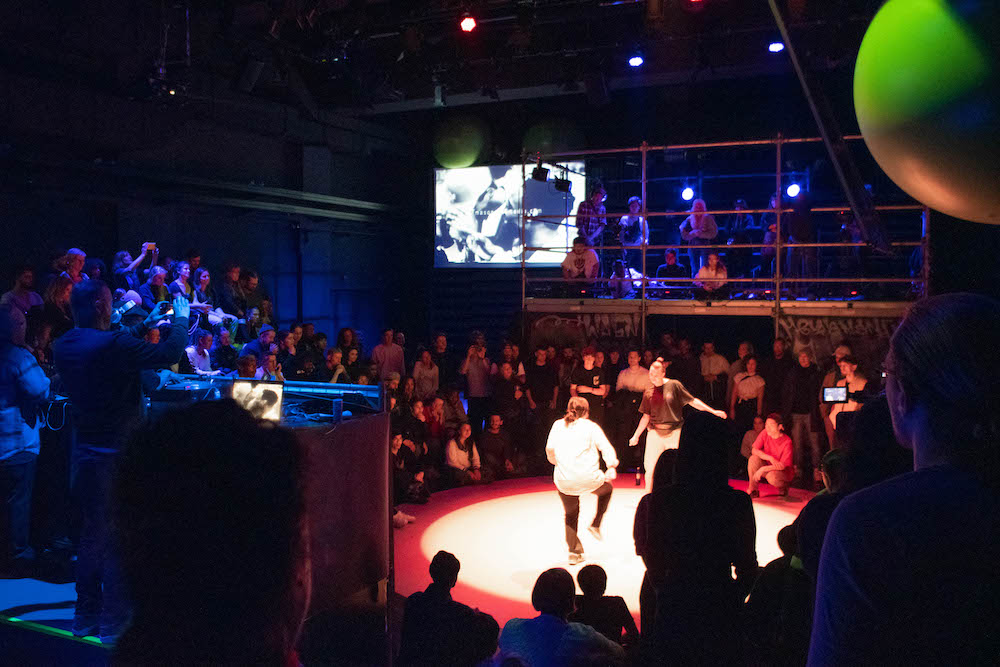
“For the Wagner Project in Oita, we focused on this element of mobility when developing the venues’ spatial design. We wanted to harness those ways to move throughout the city — for example, using truck beds as stages.
“After the event’s end, these elements can be assimilated as part of the town’s fabric, ready to be reused for the next new event in town, or even transported elsewhere as part of a travelling roadshow. Our goal was to design a flexible system.
“The Wagner Project was, in a sense, an education-oriented event, tailored toward fostering audience and young performers’ acuity toward hip-hop. But the infrastructural system itself could even be applied to medical or municipal projects.
“Despite being a mobile caravan, fluidly traveling onto the next, the concept still allows each site to demonstrate their own unique dynamics, constantly evolving to create new interrelationships.
“Importantly, I think the ability to scale up and deploy this system across Japan, for example, suggests a viable hint toward revitalising imperilled regional and rural areas that will continue to atrophy in the future.”
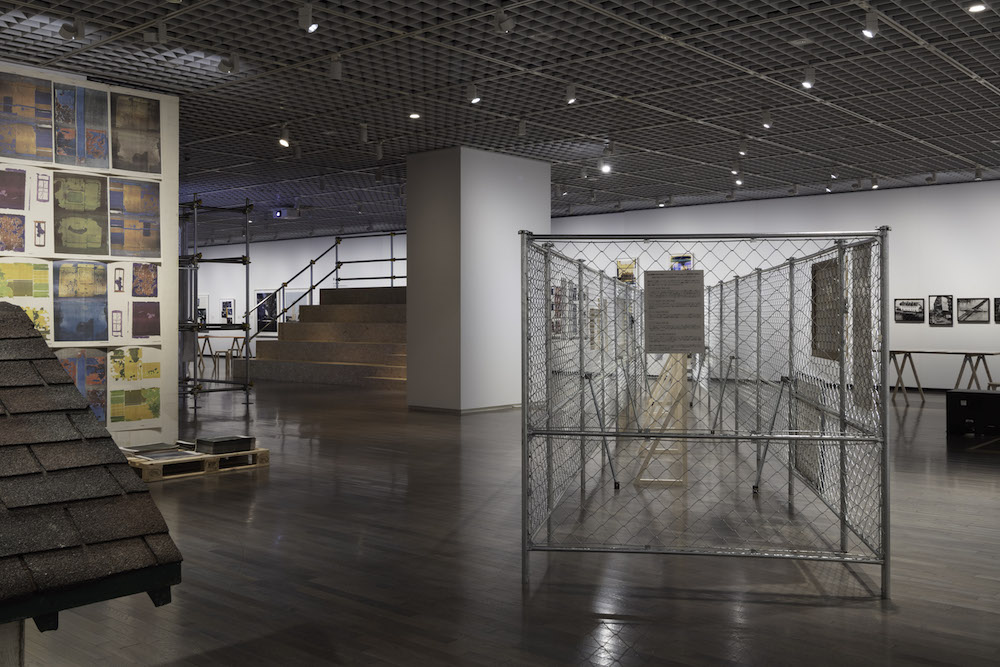
Gordon Matta-Clark : Mutation in Space (2018) / BEZOAR by Charlotte Dumas (2020)
A curator from the National Museum of Modern Art, Tokyo, was among the audience at an iteration of the Wagner Project. When MoMAT held Mutations in Space, a retrospective for Gordon Matta-Clark, in the summer of 2018, they asked Kobayashi and Uemura to oversee the spatial design.
Matta-Clark’s tragically short life coincided with the halcyon New York of the 60s and 70s. Before the city was washed out by a tidal wave of cash, before the developers’ radar saw outside of Manhattan, the South Bronx provided a fertile stomping ground rich in dereliction and decay. On the liminal cusp of a city in flux, Matta-Clark problematised the urban environment through architectural interventions that compelled a more visceral engagement with place and space.
In Splitting (1974), Matta-Clark sliced a suburban home nearly in half, leaving a gaping maw that allowed the outside light to filter through, illuminating the rising eviction and vacancy rates eating away at placid suburbia.
When not wielding chainsaws, the artist could be found frolicking in a makeshift treehouse and bathing on the face of an abandoned clock tower, in riotous experimental performances that challenged the edifices of public space and societal constraints.
The MoMAT retrospective was curated to give visitors a vicarious taste of Matta-Clark’s thinking about architecture, when the bulk of his oeuvre can otherwise only be accessed today in the form of archival images and footage. Kobayashi set out to encourage two modes of interaction with the exhibition, blending active engagement and free exploration, in a design aimed at rekindling visitors’ involvement with their city and physical surroundings.
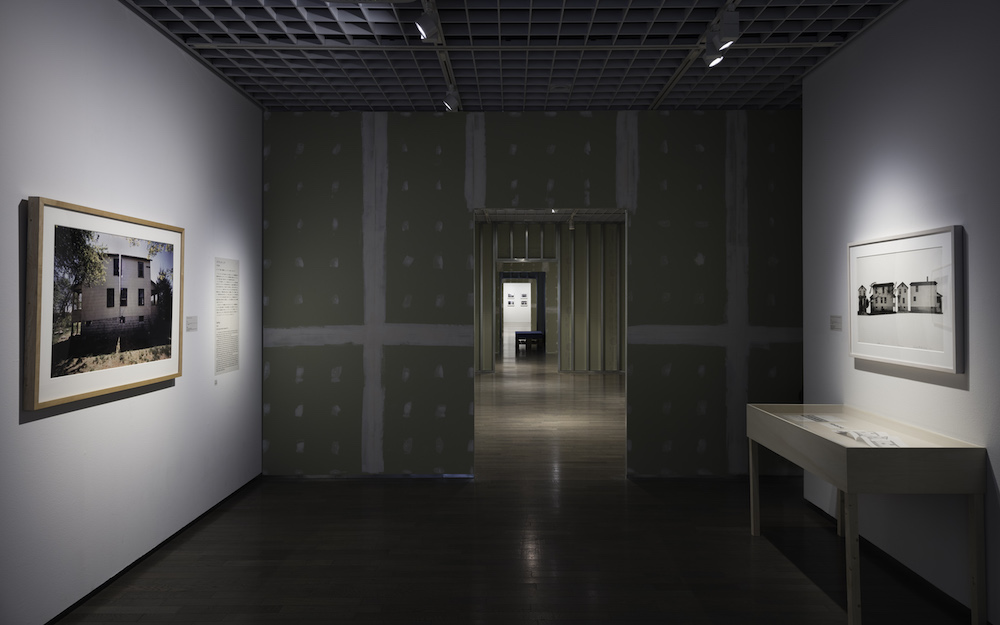
“Beyond the artwork exhibited on the walls, I wanted to also make use of the dead space in the galleries, transforming these areas into something akin to a communal park or vacant lot, thereby incorporating fragmentary elemental slivers of the spaces and situations that constitute cities.
“Museums are special spaces, visited by people of all ages and walks of life. I’m interested in how spaces affect behaviour. As museum-goers moved through these neutral areas in the galleries, we could observe this remarkable phenomenon, where people from all these diverse backgrounds engaged in the same motions, peering with their heads next to each other, sitting together as if in their own living room, just spending relaxing time together with total strangers as if it were the most normal thing.”
This use of neutral space would be a theme Kobayashi continued to explore in BEZOAR (2020), which prominently featured aizome indigo-dyed textiles.
“Textiles open up the design possibilities as a soft countervail for the ‘rigidity’ of architecture. More than just tactile softness, cloth is also experienced as a visual and sensory softening effect.
“Textiles can be used to inter-posit voids without limiting or confining. They literally elevate a space, suspending its essence in midair. I think textiles are indispensable in allowing opposites to coexist: discontinuity and continuity, severance and connection.”
Spaces for further human freedom
These projects speak to the crux of Kobayashi and Uemura’s practice as designers, who conceive of architecture as impermanent spaces, fluidly evolving to accommodate a spectrum of functions.
“There’s something very compelling about unbuilt, unrealised projects in particular that captures the imagination of modern audiences.
“I feel the counterculture of the 1960s and ‘70s has begun to come full circle. The philosophies espoused by Price, Archigram, Matta-Clark, and other artists active in England and New York not only dovetail with modern day thinking, but are even becoming mainstream.
“These artists were visionaries. Actually building their plans was secondary. The concept was what mattered and what survives as part of a larger narrative on architecture and space. I think there is tremendous meaning in focusing on and trumpeting such conceptual, intellectual visions.
“In Japan, rapid population decline is bound to dramatically reshape our cities and architecture. It is imperative that we design creative solutions for the long-term future. And in Japan, structures themselves have a rather short expiration date. We cannot expect what we build now to keep up with the speed of trends, not to mention constant environmental and technological change. But there is something that won’t change: the physicality of the human body, the end user, as a universal common denominator. Going forward, I think we must look for ways to better leverage these corporeal considerations, designing architecture and spaces as an extension of the body, or perhaps as an intimate dance partner to the bodily behaviours”
As if through cellular action, our bodies flesh out space and give beating pulse to the recombinant city. Man melds with space in organic symbiosis, the future city imbued with an enduring lifeforce of its own. One is reminded of a line from Arata Isozaki’s eulogy for his mentor, Kenzo Tange:
“Architecture is more than simply laying out a structure or a town’s grid. One must consider every facet of the lives of the people who will live there and deftly assemble your plans in a way that allows people to see these elements, on every level from society to city to nation. That’s the true meaning of architecture, as taught to us by .”
This humanist sentiment remains a guiding light, illuminating the broader meaning, the all-encompassing onus of architecture. The structures and spaces we erect may have fleetingly finite lifespans. Jagged clumps of concrete and splintered wood will be all that is left of our monuments, before they turn to ash.
However, the stories and aspirations of their creators will live on in the collective memory of society, as the recombinant DNA begetting ever further spaces for human freedom.
Special thanks to Daniel González for translation